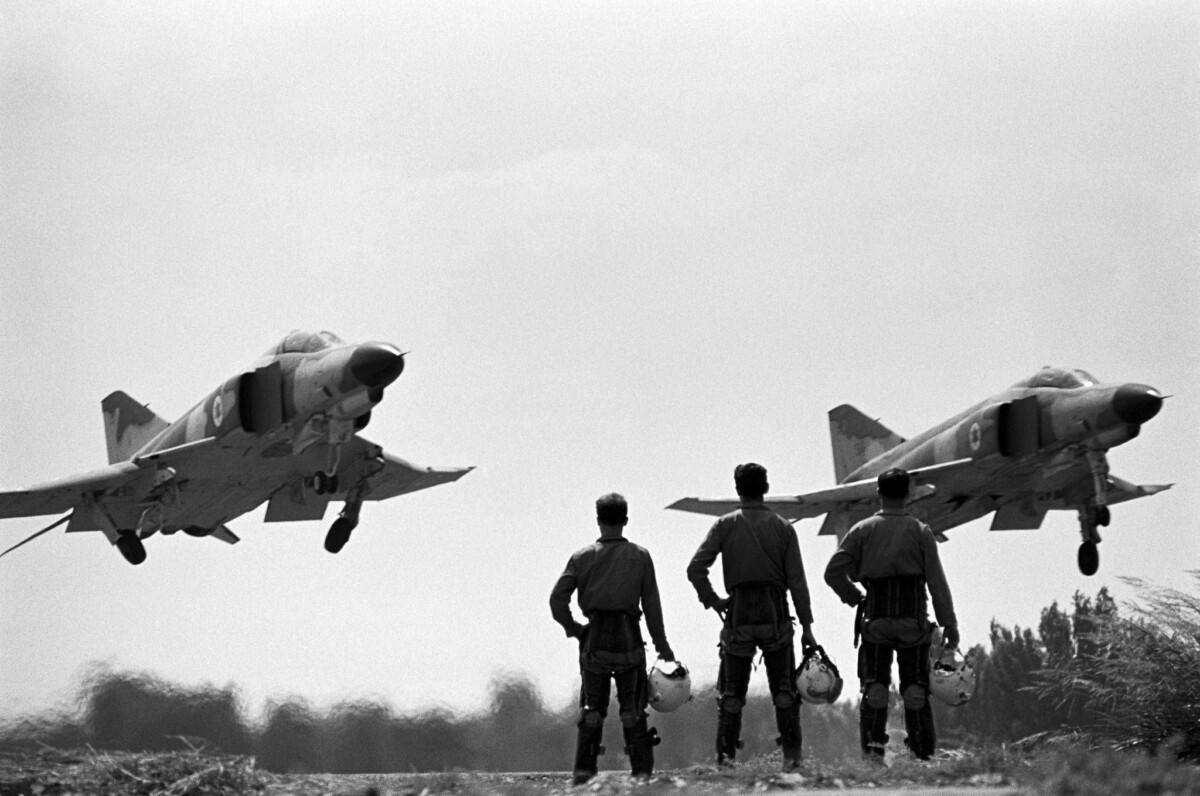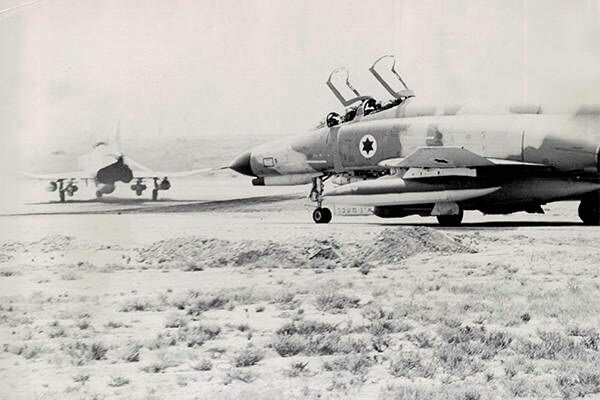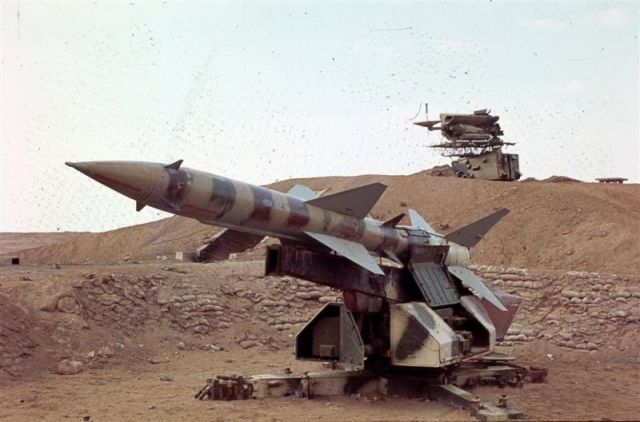Operation Dogman-5: The Israeli Phantom Massacre of 1973 &
Lessons for the Joint Force Today
PDF Version
By: 2nd Lt. Grant T. Willis, USAF | Sep 22 nd 2022
An
Illusion of Invulnerability

By the start of
the Yom Kippur War in October 1973, the Israeli Air Force (IAF) was one of the most feared and professional
Air Forces in the Middle East, but it would be humbled by hubris and a
breakdown of confidence in pre-war objectives which were rehearsed and
developed for years. The IAF was the primary blunt instrument for Tel Aviv to
buy time for the Israeli reserves to be called up and sent to the fronts.
Like a coiled spring, the IAF was trained to preemptively strike out against
its hostile neighbors to take away the enemy’s first strike advantage against
the tiny IDF regular forces stationed along the thin frontiers along the Suez
Canal and Golan Heights. This coiled spring, that had trained to shape
the momentum of battle, was only released after the Arab Air Forces had taken
off and the artillery batteries opened fire. The shock of 1967 Arab
defeat would be no more with the Egyptian and Syrian Air Defense Forces fully alerted
in anticipation of the precious Phantoms and Skyhawks sure to arrive from
beyond the horizon.
Simplicity and
the comprehension of strategic intent from the bottom up are fundamental in the
success of any military operation.
Making military objectives and concentration of effort clearly defined
and obtainable are essential to victory.
To utilize one’s military assets, such as the finely tuned IAF,
piecemeal and in a panicked, reactionary, or uncoordinated manner is to invite
disaster. If a complex operation,
especially an air campaign, is designed in accordance with a specific master
air attack plan (MAAP) then it is inherently dangerous to seriously deviate
from a pre-war concept of operations (CONOP) without understanding the
implications or consequences of such a deviation.
Days
of Desperation

October 7th, 1973,
proved to be a disastrous date in the history of the Israeli Air Force
(IAF). After the surprise combined
Egyptian and Syrian attack against the Jewish State the day prior, the IAF was
called upon to perform its critical role of holding off the hordes of Arab
armor and mechanized forces while the Israeli Defense Force (IDF) reserves were
organized. A pre-planned IAF operation,
codenamed Tagar, was practiced for three years
to strike Egyptian air bases and Soviet influenced air defense sites on the
Western side of the Suez Canal. Tagar launched early on October 7th with a full
package of over 80 aircraft including, stand-off electronic warfare (EW) helicopter
jammers, Kc-97 tankers, and a powerful mix of A-4 Skyhawks, F-4E Phantom IIs,
Mirage IIIs, and Neshers. The strike was not effective in suppressing
the Egyptian Air Defense Command and failed in effectively knocking out the
primary Egyptian air bases.[1] As the
first wave of strike crews returned to their bases, they were shocked to find the
Defense Minister, Moshe Dayan, had called off Tagar
and ordered the Chief of the Air Force, General Benny Peled, to “send the air
force north”, instead of continuing their planned campaign against Egypt.[2] Although
Peled and his staff attempted to argue and counter the order, Dayan was adamant,
and the strike on the Syrian Front was carried out.

Approaching
the Red Line
The operation against
Syria codenamed, “Model-5” a.k.a “Dogman-5” was
intended to destroy the primary Syrian air defense umbrella covering the sector
opposite the Golan Heights.[3] The Egyptian penetration into the Sinai was a
mere 10 Kilometers with a large buffer between the pre-war Suez Front and the
pre-1967 Israeli southern border. In
contrast, the Golan Front was blown wide open by 5 Syrian mechanized and
armored divisions.[4] Beyond the Golan and the bridges spanning the
Jordan River lay the heart of the State of Israel. This immediate threat by the Syrians to
overrun the North, panicked Israeli Command, recalling the Air Force from their
current operation against Egypt and sending them North to execute Dogman. After the
Syrian Air Defense threat was sufficiently suppressed, it was thought that the
IAF could execute their other objective, providing effective close air support
to the thinly stretched IDF units attempting to hold off the Syrian onslaught
while reserves were scrambling towards the front. The IAF ground crews worked tirelessly to
rearm and refuel the strike force for the Northern operation and launched
immediately.

The
specific objective for the strike force was to destroy the Syrian SA-2 and SA-3
surface to air missile (SAM) batteries along with their associated Fire Can,
Long-Track, Low Blow, Flat Face, and Fan-Song target acquisition radars.[5] The Arab pre-war preparations and Israeli
post-1967 hubris combined to create a deadly day for the IAF. The IAF strike package lacked many of the
entities that were required to make a successful suppression of the Syrian air
defenders including No. 200 Squadron’s decoy drones, intended to deceive the
SAM battery commanders and draw fire.
The IAF’s intelligence also failed to utilize effective Image
intelligence (IMINT) and electronic intelligence-electronic support measures
(ELINT-ESM) to provide their flight crews with up-to-date information on the
location and status of the Syrian defense.
The high-altitude coverage by the SA-2 and SA-3s forced the IAF strikers
to go in low, directly into the envelope of conventional anti-aircraft
artillery (AAA) sites, mobile radar-guided ZSU-23-4 “Shilka”
AAA, and the Soviet-made man-portable air defense system (MANPADS) SA-7 “Grail”.[6] The low-altitude air defense weapons would
take their toll against the IAF. 6 of
the 99 available F-4E Phantom IIs were shot down with a further 6 strike
aircraft returning to Ramat David Air Base heavily damaged. 2 aircrew were killed with 9 pilots and
weapon systems officers/navigators taken as prisoners of war (POW).[7] In return, the strike force managed to
destroy 1 SAM battery and 0 radars. For
the IAF, this was a disaster. Combined
with the losses suffered on the 6th of October, General Peled, reported to the
Chief of Staff, David Elazar, that the Air Force was nearing its “red line”
status of available combat aircraft.
After only one week of fighting, the IAF had lost 80 combat
aircraft. These losses amounted to 24
percent of Israel’s inventory in October 1973.[8]

Bad news also
came from the ground forces as 8 October resulted in a similar defeat for the
IDF’s armored corps in the Sinai. The
Egyptian light infantry and commandos, lying in wait on the Eastern side of the
canal, were armed with Soviet-made anti-tank weapons such as the AT-3 “Sagger” anti-tank guided missile (ATGM) and rocket
propelled grenades (RPG-7), which inflicted devastating losses on General
Avraham Adan and General Ariel Sharon’s armored divisions attacking the
Egyptian 2nd and 3rd Armies.[9] The effective Egyptian and Syrian defenses
against the IDF’s counterattacks in the early days of the war illustrated the
importance of stamping out hubris from one’s military preparations. The IDF/AF would eventually snatch victory
from the jaws of defeat and reverse their military setbacks from the first days
of the Yom Kippur War by routing the Syrians to the gates of Damascus and
crossing the Suez Canal with three armored divisions, but the cost to achieve
this victory was too high a price to accept.
The decision to direct the IAF to
strike north rather than continue the operational plan and pre-briefed concept
of operations against the Egyptians has been a highly debated and a controversial
legacy within the IAF post-1973. In A
War of Its Own by Professor Uri-Bar Joseph, newly examined archive
documents have highlighted details and analysis on the Israeli Air Force’s
inability to “stick to the plan”. In the
United States Air Force, it is common in de-briefs for combat crews to be berated
by instructors for “not doing what you briefed” if the crew performs
sub-standard. A similar critique can be
attributed to the IAF high command in the opening days of the war. The panic inspired by the shock of the combined
Arab assault sent the IAF into a spiral of indecision. The shock forced attention to one theatre
while pausing and shifting to another without a coherent intent. This leapfrogging course of action resulted
in concentrating on little while achieving nothing to influence the overall battle
until Israeli armor could destroy SAM sites at point blank range with their
main guns to clear the way for the IAF to break through the “SAM wall”. This stood in sharp contrast to the
experience in 1967, when the tiny Israeli air component concentrated their
attacks on one Arab air arm at a time, destroying one air force in detail and
re-directing to another. In the Times
of Israel article, “Newly Opened Archives Show Israel’s Air Force Was A Weak
Link During the Yom Kippur War”, Abraham Rabinovich
further illustrates the comparison between the IAF in 1967 and 1973 by stating,
“Veteran officers on Peled’s staff believed that his
much-admired predecessor, Gen. Motti Hod, who had
carried out the preemptive strike in 1967, would have found a way to keep Tagar alive, either by explaining the situation to Dayan
more persuasively or otherwise. Two
years before, Hod had witnessed an Egyptian division deployed along the Suez
Canal as if preparing to cross. The Egyptian force was lined up densely for
miles on a narrow road leading to the waterway — tanks, personnel carriers,
fuel trucks and the myriad of other vehicles an army requires to go into
battle. Hod ordered his staff to draw up a detailed plan to attack any such
formation at the beginning of a future war. The plan’s code name was “Srita,” Hebrew for “Scratch.” When the Yom Kippur War broke out, Hod
expected Peled to unleash the attack on one or more crossing points of the
canal to throw the Egyptians off balance. But rather it was the IAF that was
off balance. Expressing his deep disappointment in Peled later, Hod said, “He
had only to say [into the radio] ‘Srita. Execute.’
The air force knew what to do.”[10] The lessons learned from the 1973 Arab Israeli War would inspire
innovation and development of new methods championed by both the IAF and the United
States to defeat the SAM. The setting of
military momentum against your enemy early and retaining it is also a concept
that 21st century war planners must consider as a key take away from
the IAF’s 1973 experience.
Conclusions
and Lessons Learned
Hubris in any professional military
force is inherently dangerous. The
current military adventure by Vladimir Putin’s Russia in the Russo-Ukrainian
War of 2022 presents us with an opportunity to evaluate performance and weigh
pre-war conceptions of effectiveness of an adversary. We should be careful in our conclusions
regarding the preparations we make for contingencies in Europe, the Middle
East, and the Pacific. The Russian Air
Force’s failure to win air supremacy over Ukraine and its high loss rates
produce valuable lessons to be learned by future war planners, but an even more
studious evaluator is closely counting the costs, Beijing. The People’s Liberation Army (PLA) will watch
the outcome of this war and its vicarious lessons in armor, anti-tank weapons,
public relations, troop morale, amphibious assaults, artillery, modern
missiles, and air power. In 1973, the
missile had bent the wing of the aircraft and from 1982-1991, the aircraft had
bent the missile. This is a cycle of
technological innovation that swings a pendulum back and forth, war after
war. The Pacific Alliance should consider
this pendulum and examine it carefully to ensure that the United State Air
Force and our Naval Aviation elements do not find themselves at the receiving
end of the next deadly swing. The
suppression of enemy air defenses (SEAD) will continue to plague war planners
for years to come and the innovation of unmanned systems integrated with all
other elements of modern air power will be required for winning the battle for
the skies in any future near-peer contest.
Another
key learning point from the first few days of the IAF’s 1973 experience reside
in a vital principle of warfare, simplicity.
Of course, striking an IADS is anything but simple, but the orders to
immediately execute coordinated combat operations against the enemy can either
be simple and easily relayed or complicated and filled with hesitation and
indecision. General Hod’s “Srita Execute” OPLAN is a fundamental take away from this work. In the Pacific, the vast expanse of the
combat area and the complications of modern command and control (C2)
interference must be expected. This will
require a level of simplicity in the execution of a defensive war plan that
requires years of training and unit development with the intent of being able
to effectively respond to a PLA amphibious assault with no more than a one-line
command from headquarters, “Execute”. Any
air campaign, with assets responding to the battlespace from many islands,
aircraft carriers, and continental bases spread over thousands of miles must be
able to begin the cycle of response in a timely and efficient manner with
little misunderstanding involved. This
concept cuts down on hesitation which can derail any modern force operating in
an environment containing hypersonic weapons, cyber weapons, and anti-satellite
technology. Understanding the value of
context behind the development of modern warfare through the ages to our modern
day is an essential tool in building the fundamentals upon which we can develop
our doctrine and tactics, techniques, and procedures (TTPs) that future leaders
must employ to deter and defeat our foes of tomorrow. With this context, like the bloody history of
the IAF in 1973, we can avoid such dilemmas, out preparing and out planning our
enemies.
“Courage
is useless in the face of educated bullets”- Gen. George S. Patton, Jr.
Author
Biography:
2nd
Lt Grant T. Willis, USAF
Lieutenant
Willis is a Remotely Piloted Aircraft (RPA) pilot currently stationed at Cannon
AFB, NM. He is a graduate of the University of Cincinnati with a Bachelor of
Arts and Sciences, majoring in International Affairs, with a minor in Political
Science.
Sources:
Aloni, Shlomo,
and Chris Davey. Israeli F-4 Phantom II Aces. Oxford: Osprey Publishing,
2004.
Emran,
Abdallah, and Tom Cooper. 1973 – The First Nuclear War: Crucial Air Battles
of the October 1973 Arab-Israeli War. Solihull, West Midlands: Helion & Company Limited,
2019.
Rabinovich, Abraham, Nebi
Qena and YURAS KARMANAU, Agencies, TOI staff, Afp, Chris
Megerian, Emanuel Fabian, et al. “Newly Opened
Archives Show Israel’s Air Force Was a Weak Link during Yom Kippur War.” The
Times of Israel, December 18, 2021.
https://www.timesofisrael.com/newly-opened-archives-show-israels-air-force-was-a-weak-link-during-yom-kippur-war/.
McNab, Chris, Johnny Shumate, and Alan Gilliland. Sagger Anti-Tank Missile vs M60 Main Battle Tank:
Yom Kippur War 1973. Oxford, UK: Osprey Publishing, 2018.
Griess,
Thomas E. The West Point Military History Series . Wayne ,
New Jersey: Avery Publishing Group , 1987.
[1] Emran, Abdallah, and Tom Cooper.
1973 – The First Nuclear War: Crucial Air Battles of the October 1973
Arab-Israeli War. Solihull, West Midlands: Helion & Company Limited,
2019.
[2] Emran, Abdallah, and Tom Cooper.
1973 – The First Nuclear War: Crucial Air Battles of the October 1973
Arab-Israeli War. Solihull, West Midlands: Helion & Company Limited,
2019.
[3] Emran, Abdallah, and Tom Cooper. 1973 – The First Nuclear War: Crucial Air Battles of the October 1973 Arab-Israeli War. Solihull, West Midlands: Helion & Company Limited, 2019.
[4] Aloni, Shlomo, and Chris Davey. Israeli
F-4 Phantom II Aces. Oxford: Osprey Publishing, 2004.
[5] Aloni, Shlomo, and Chris Davey. Israeli
F-4 Phantom II Aces. Oxford: Osprey Publishing, 2004.
[6] Emran,
Abdallah, and Tom Cooper. 1973 – The First Nuclear War: Crucial Air Battles
of the October 1973 Arab-Israeli War. Solihull, West Midlands: Helion &
Company Limited, 2019.
[7] Aloni,
Shlomo, and Chris Davey. Israeli F-4 Phantom II Aces. Oxford: Osprey
Publishing, 2004.
[8] Griess, Thomas E. The West Point Military History Series . Wayne
, New Jersey: Avery Publishing Group , 1987.
[9] McNab, Chris, Johnny Shumate, and Alan Gilliland. Sagger Anti-Tank Missile vs M60 Main Battle Tank: Yom Kippur War 1973. Oxford, UK: Osprey Publishing, 2018.
[10] Rabinovich, Abraham, Nebi Qena
and YURAS KARMANAU, Agencies, TOI staff, Afp, Chris Megerian, Emanuel Fabian,
et al. “Newly Opened Archives Show Israel’s Air Force Was a Weak Link during
Yom Kippur War.” The Times of Israel, December 18, 2021.
https://www.timesofisrael.com/newly-opened-archives-show-israels-air-force-was-a-weak-link-during-yom-kippur-war/.